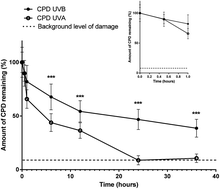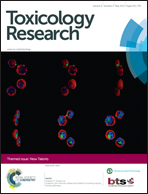Rescue of cells from apoptosis increases DNA repair in UVB exposed cells: implications for the DNA damage response
Abstract
Classically, the nucleotide excision repair (NER) of cyclobutane pyrimidine dimers (CPD) is a lengthy process (t1/2 > 48 h). Using the T4 endonuclease V-modified comet assay, we uniquely found a far more rapid repair of UVA-induced CPD (t1/2 = 4.5 h) in human skin keratinocytes. The repair of UVB-induced CPD began to slow within 1 h of irradiation, causing damage to persist for over 36 h. A similar trend was noted for the repair of oxidatively-modified purine nucleobases. Supportive of this differential repair, we noted an up-regulation of key genes associated with NER in UVA-irradiated cells, whereas the same genes were down regulated in UVB-irradiated cells. There were no significant differences in cell viability between the two treatments over the first 6 h post-irradiation, but after 24 h apoptosis had increased significantly in the UVB-irradiated cells. The role of apoptosis was confirmed using a pan-caspase inhibitor, which increased CPD repair, similar to that seen with UVA. These data indicate that the cellular ‘decision’ for apoptosis/DNA repair occurs far earlier than previously understood, and that the induction of apoptosis leads to lesion persistence, and not vice versa. This also highlights a new, potential increased carcinogenic risk from UVA-induced DNA damage as, rather than undergoing apoptosis, high levels of damage are tolerated and repaired, with the attendant risk of mutation.

- This article is part of the themed collection: New Talents

 Please wait while we load your content...
Please wait while we load your content...